What is a heart attack?
The heart is a pumping organ which pumps blood to the brain and all the organs of the body for their normal functioning of the body. The heart also however needs blood to pump normally and this blood is provided via the coronary arteries or the arteries of the heart. (See section: Coronary angiogram)
Heart attack is a condition where there is a sudden partial or complete block of the coronary arteries usually by a blood clot. When this sudden block occurs the blood supply to the heart gets reduced or stopped and the pumping efficiency of the heart gets reduced and thus blood supply to the brain and organs are suddenly reduced. Depending on the artery involved and the location of this block the heart attack can be massive or less severe. Generally blocks which occur in the Left main, and beginning portions of the LAD, LCx and RCA can be massive and can result in cardiac arrests and be fatal if not attended to immediately.
What is a Primary angioplasty and how is it different from a planned angioplasty?
Primary angioplasty and stenting is an emergency and un-planned procedure that is done as a life-saving procedure, to open the block during a heart attack. Primary angioplasty is different from a usual angioplasty in that clots are the culprit in the heart attack which are usually absent in a planned angioplasty. The clot can be very difficult to manage and they have the risk of getting dislodged and going into the smaller branches and causing a further reduction or complete stoppage of blood flow to the heart muscle and a cardiac arrest.Also during a heart attack, the patient’s blood pressure and heart rate are unstable which can make the performance of the angioplasty more challenging.
The procedure is similar to the conventional angioplasty. Initially an angiogram is performed to identify the location of the block. (See Image)
The image shows a 100% sudden block of the RCA which caused blood pressure fall and a very low heart rate with a risk of heart stopping or cardiac arrest
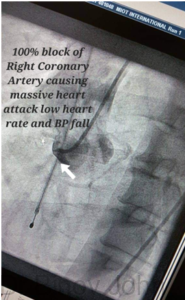
A temporary pacing wire (See: Pacemaker section) was passed through the neck vein to act as a temporary backup to increase the heart rate and prevent cardiac arrest. (See image)
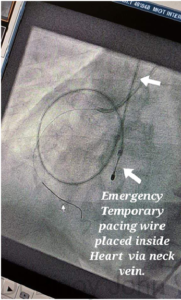
Then a wire is passed into the artery to cross the block. Often the block is 100% and passing the wire through the block can be challenging. (See image) The success of the angioplasty depends on the ability to pass the wire across the block.
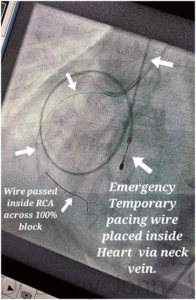
After the wire is passed, if the clot load is high a catheter is passed inside the artery to suck out the clots. (See image)
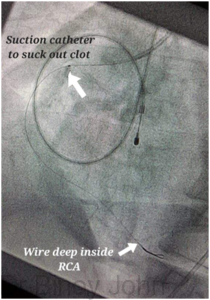
The clots removed can be seen when the catheter is flushed. (See image)
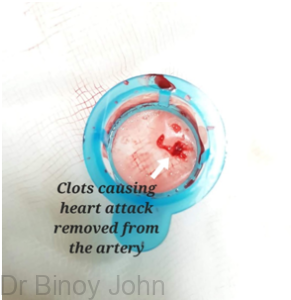
Removal of the clots will expose the underlying block which is present (See image).
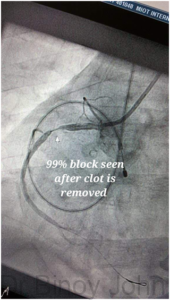
At times there may not be any obstructive blocks. In cases where no blocks are seen the cause of the heart attack could be just a 10 or 20% plaque rupture leading to a huge clot formation from the chemical reactions due to the plaque rupture.
If a block is present the block is opened up with a balloon. (See image)

Thereafter a stent is positioned across the block and deployed (See image),
to achieve complete opening of the block and brisk flow in the artery and its branches and thus to the heart muscle. (See image)
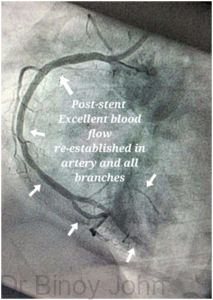
Expertise: Dr Binoy John is an expert in Primary angioplasties and has saved many hundreds of patients with acute heart-attacks.
Watch Video: Watch how a Primary angioplasty is performed in a young person who presented with a massive heart attack of the RCA with a huge clot load:
Testimonial:






